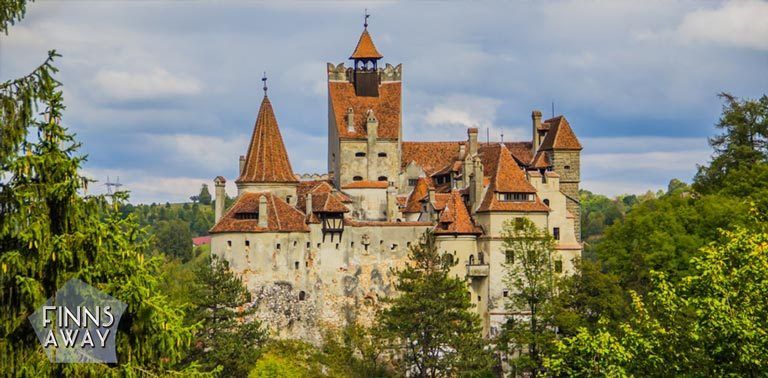
Over the mountains and far away
In this post we continue the East Europe road trip over Carpathian mountains, and head east to Moldova through central Romania. On the way we witness a violent thunderstorm, visit two Dracula castles and observe the way of living in Romanian countryside.
Transfagarasan road over the Carpathians
 Transfagarasan road going over Fagaras Mountains was constructed in the early seventies, by an order of Nicolae Ceausescu, to serve as a military road. Construction of the road came with high cost, not only financially, but for the price of human lives as well. It was built mainly by junior military personnel in rough alpine climate and conditions. Roughly six million kilograms of dynamite was used to blast rock, and officially 40 workers lost their lives during the four and a half years of construction. In unofficial estimates the number of casualties is measured in hundreds.
Transfagarasan road going over Fagaras Mountains was constructed in the early seventies, by an order of Nicolae Ceausescu, to serve as a military road. Construction of the road came with high cost, not only financially, but for the price of human lives as well. It was built mainly by junior military personnel in rough alpine climate and conditions. Roughly six million kilograms of dynamite was used to blast rock, and officially 40 workers lost their lives during the four and a half years of construction. In unofficial estimates the number of casualties is measured in hundreds.
As a result of this ambitious project, the 90 kilometers long and winding paved road goes over the Carpathians between the two highest peaks in Romania, Moldoveanu and Negoiu, and connects Transylvania to Wallachia area. The highest point of the road is at an elevation of 2 042 meters, next to Balea glacial lake. Due to rough conditions up in the mountains, the road is usually open only from May to October, and might get temporarily closed even during summer.
Driving through the road is marketed as one of the top experiences in Romania, and since we were in the area after hiking in the Fagaras mountains, it was a must to check it out. We drove from the north, where the Transfagarasan road (7C) begins in the small town of Cartisoara. First part of the road is flat, and rugged wall of Fagarasan mountains is an impressive sight standing right in front of you. In the north the ascent up is steep, which makes the views spectacular. When the winding part with hairpin turns begins, it comes clear that the route is popular among tourists. Traffic is quite dense, and there are lot of cars parked along the road. Some lunatic cyclists sweat their way to up, for sure an unforgettable but dangerous experience.
Balea waterfall comes down right next to the road, and there is a really touristy lay-by whit a chalet, restaurant and a lot of stalls selling all kinds of souvenirs. When reaching the top, the tourism hassle gets even worse, and the whole area and shores of beautiful Balea lake are full of people taking selfies. Views are stunning of course, but we really prefer watching the mountains from hiking paths instead. All in all the Fagarasan road experience was somewhat lame for us, maybe because we had just been high up in the mountains, almost alone in the middle of the magnificent peaks.
Lake Vidraru and a thunderstorm
After the highest point up in the mountain pass, the road dives into a tunnel, and then the descent to the southern side begins. Views are nice on that side also, and after some zig-zagging the road reaches the Lake Vidraru with turquoise waters. This huge artifical lake was created on 1965 when 166 meters high Vidraru Dam was built in the Arges river. We stopped for a night near the northern end of the lake in awesome (but bit pricey) Cabana Cumpana. We had a nice lake view from the balcony, and enjoyed the tranquility for a moment. Soon turned out that it was a moment of calm before the storm.
During the day there had been a violent storm going over western Romania, with deadly strong winds tearing off roofs, damaging cars and uprooting trees. Over 60 people were injured due to flying objects, and 8 people lost their lives. In the mountains the storm hit later in the evening, in form of a thunderstorm. We witnessed from the balcony how the lightning show started and how the storm quickly came down to the valley and swept over. The winds were momentarily horrifyingly strong, and it was pouring with rain. The worst part lasted just minutes, followed by fireworks of lightnings that lasted for hours. Some fellow travelers had just raised a tent next to the lake, it was a miracle that they managed to keep it on the ground, surely they were soaking wet. The cabana lost electricity and internet connection, but they had generators to keep the lights on.
Vidraru dam and the real Dracula castle
The next morning was again perfectly calm, with no sign of the storm. Or so we thought until continuing our way down the Transfagarasan road. There were several fallen trees over the dirt road to the cabana and over the power lines. Luckily somebody had already cleared the way so much that we could get past (or under) the trees. The main road continued winding and hugging the shores of the Lake Vidraru. In the southern end we reached the huge Vidraru Dam with awesome views.
Short after leaving the lake behind, we visited the ”real” Dracula castle, the Poenari Fortress close to town of Arefu. The castle was built on 13th century by Wallachians, and Vlad Tepes, the model for Bram Stoker’s novel character Dracula, actually lived there in 15th century. The citadel has been in ruins since 17th century, and in 1888 parts of the castle fell down to a river far below due to an earthquake and landslide. The former citadel can be reached by climbing up 1480 concrete stairs (which is particularly nice after four days of hiking in the mountains 🙂 ) and paying the entrance fee of 5,80 RON (less than 1,5 €). Worth of visiting, definitely.
Road trip towards Brasov
Next stop was in Curtea de Arges, where we stayed couple of days in Pension Mikelis. It is a nice small town with delightfully lot of restaurants and cafes, and some sights like a monastery and churches. After moving on to a small village of Leresti near Campulung, we stayed in excellent Amada Pension, ate traditional Romanian dishes like ciorba soups, mamaliga (baked polenta with cheese) and pork neck, and followed the countryside life from close range. Horse carts are still widely used and chickens run freely on the yards. Everybody seems to have at least one dog, and there is a huge amount of stray dogs running around also. We met several times with an old man walking his goats along dirt roads next to a stream, wondering what was the purpose of that routine. This gap-toothed oldster with warm smile even tried to talk with us, but with no common language we only understood that he wanted to know where we are from.
On the way to the city of Brasov, we stopped in Bran, one of the most touristic towns in Romania. It is famous for the jaw-dropping Bran Castle, which is a landmark and national monument of the country. It is often referred to the home of Dracula, even if this castle hasn’t much to do either with the novel or Vlad Tepes. However, it is a picturesque castle from 13th century, nowadays a museum and popular tourist destination. It really shows when arriving to Bran; there is huge amount of tourist services, cafes, restaurants and of course stalls selling Dracula T-shirts and all souvenirs you could imagine. Entrance ticket to the castle and museum is quite expensive, around 8 euros, so we just admired the sight from the opposite side of the street where some hiking routes climb up the slope.
Close to Bran and Brasov there is again another mountain area, the Bucegi Mountains. Together with Fagaras, it is the most popular hiking destination in Romania. If only the weather would have been better (it was raining for few days) we would have hit the trails there as well. Now we just stayed in Brasov for couple of days, first in nice Vila Borgo outside of the city center and then right next to the old town in a homey room booked via Airbnb. Brasov is filled with history and old structures like the city wall and gates, Citadel Fortress, towers and churches. Tampa mountain is basically in the middle of the city, and there are great views from the top, reached either by a cable car or along walking paths.
Moldova calling
At some point the plan was to drive to Bucharest right after Brasov, but we decided to head first to Moldova in the east. Never been there before, and not sure what to expect of the country that is one of the least visited and poorest in Europe. On the way east we stopped in the town of Onesti and stayed in a worn-down Motel Popas Basarabia, an interesting place with not much comforts but friendly service. Drive further towards Moldova took us in the middle of rural areas and field landscapes. Horse carts sometimes dominated the traffic, and there were fruits sold on the side of the road. One memorable sight was a man selling huge watermelons from the trunk of his old, yellow Dacia. Should have stopped and took a picture, oh and why not to buy one melon from him also.
When reaching the border near Albita, we got the first stamps of the new FinnsAway life in our passports. Had to show car registration documents and the certificate of insurance (green card) as well, but it was still nice and easy crossing with no queues. We bought a vignette for driving in Moldova for seven days, let’s see if one week is enough time to explore this small but interesting country!





